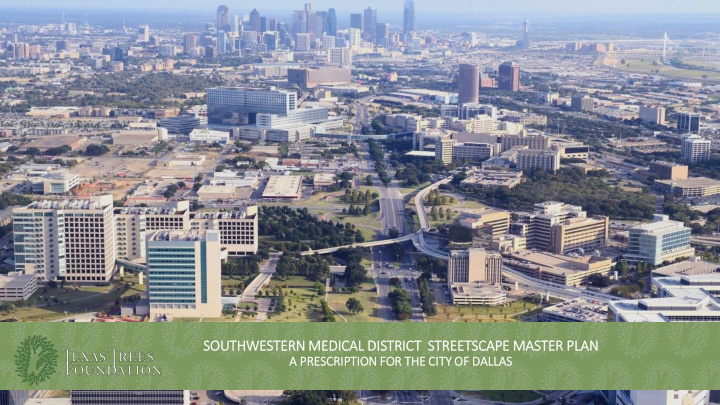



SO SOUTHWESTERN MED EDIC ICAL DIS ISTRIC ICT STREETSCAPE MASTER PL PLAN A PR PRESCRIP IPTION FOR THE CITY CITY OF OF DALLAS
URBAN HEAT IN DALLAS Surface Paving Area Across Dallas Tree Canopy Cover Across Dallas (% of ½ km 2 grid cell) (% of ½ km 2 grid cell) US Forest Service recommends an average tree canopy cover of 40% Da Dalla llas has as 28 28% SWMD has as 7% 7%
MANAGING URBAN HEAT Warm Season [May-Sept.] (Average Daily High Temp)
S O UTHWESTERN ME D I CAL D I STRI C T AS AN UR BAN H EAT C AS E ST UDY • 37,000 Employees • 2.8 million annual visits to clinics & ERs • 3,600 students/ residents/fellows • 16+ miles of transportation corridors • 35,000-45,000 vehicles per day projected on Harry Hines
EXISTING CONDITIONS: TREE CANOPY 5
EXISTING CONDITIONS: TREE CANOPY ALONG STREETS 6
EXISTING CONDITIONS: TREE CANOPY ALONG STREETS 7
EXISTING CONDITIONS: MISSING SIDEWALKS 8
EXISTING CONDITIONS: STORMWATER MANAGEMENT
EXISTING CONDITIONS: ACCOMMODATING ALTERNATE TRANSPORTATION
ISSUES IMPACTING GROWTH AND HEALTH • Hardscape Conditions • Original roads built for industrial users - few street trees • Several industrial buildings scraped to foundation • Acres of surface parking • Drainage Challenges • Changing Development Patterns • Recently opened DART light-rail stations • Former industrial sites giving way to new multi-family communities • Proximity to major employment centers, including the UTSW Clements University Hospital, New Parkland Hospital, and Love Field Airport • Limited Public Right-of-Way Along Roads
ISSUES IMPACTING GROWTH AND HEALTH • Pedestrian Safety • Hit and miss street and pedestrian lighting • Six-lane, 40 mph thoroughfares define medical district • Moving Around • Sidewalk-crosswalk network is poorly developed • Street grid defined by super blocks • Roadways are not cyclists friendly • Health and Aesthetics of a Medical District • No exercise paths or exercise stations • Limited views of greenery from patients’ rooms • Broad open space locations are restricted • Development patterns discourage walking • Overhead utility lines dominate views • Center of Medical District is a 1960s Cloverleaf
BETTER INFRASTRUCTURE CAN LEAD THE WAY! Benefits of the Plan: • Transforms and brings continuity and connectivity to the area • Improves the safety and well-being of visitors, patients, health care workers and neighborhoods and incentivizes future recruits to the medical staff • Mitigation of urban heat PEOPLE • Effective engine of economic growth in the $ increase tree diversity build on economic opportunities HEALTH area mitigate heat island effect promote safety • Creates a “sense of place” that no other SYSTEMS ENVIRONMENT medical district in the country experiences – utilize smart technology increase urban habitat national/world model improve connectivity filter/treat stormwater • Creates a healthy environment, establishes CO 2 minimize energy use improve air quality healthy ecosystems, encourages healthy lifestyles • Advances the City of Dallas Complete Streets Manual
DESIGN FRAMEWORK • The six identified strategies overlap across the street network, creating a variety of streets with unique characteristics
15
GREEN SPINE: HARRY HINES 6’ 10’ 6’ 11’ 11’ 11’ 6’ 40’ Project Objectives: 11’ 11’ 11’ 9’ 10’ Filter/treat stormwater by creating rain gardens 9’ Improve user health by providing trails for exercise Define District as destination by creating strolling arboretum experience Improve connectivity by promoting public transportation
18
C URRE NT & P ROJEC TED T R AFFI C VO LUMES T R A F F I C V O LU M E S 1. HARRY HINES BLVD - 33,000 Average Daily Trips - 35,000 - 45,000 (2045 ADT) 2. INWOOD ROAD - 49,000 Average Daily Trips - 52,000 - 69,000 (2045 ADT) 3. Majority of traffic travels through the intersection with only limited use of the interchange AP R I L 2 0 1 9 NORT RTH 19
POS OSSIBL BLE E PARK PR PROGRAM AM TEXAS TREES FOUNDAT ATION | GREEN HEAR ART T VISIO ION PLAN 20
B ENEFITS O F T HE SWMD U R BAN ST REETSCAPE MASTER P L AN When fully realized the SWMD Urban Streetscape Master Plan will transform the district with: • 23 23 acr acres s of streets reclaimed for pedestrian use, including wider sidewalks, shared-use paths, park space and sidewalk cafes • 6.5 6.5K trees planted within the public realm • 21 21 mile iles of sidewalk added along streets, in addition to the existing 12 12 mile iles of sidewalk • 73 73% of streets with a 6’ or greater pedestrian buffer, creating a safer and more comfortable walking environment • 80 80% (16 (16.8 mile iles) of streets that support integrated bicycle infrastructure • 1.2 1.2 mill illion cubic feet of rain captured and treated by rain gardens.
P O LI C Y I S S U ES Hindsight is 2020: • Lack of street grid requirements has resulted in a disconnected district that increases the burden on the few arterials that exist in the district. This is difficult to reverse. • We need better alignment between land use regulations and vision for street improvements in the District. • Require consistent streetscape development as development occurs • Ensure development that is compatible with the vision Looking forward: • U.S. Representative Eddie Bernice Johnson has tasked us with identifying and inventorying additional policy challenges that inhibit ideal project design 22
SO SOUTHWESTERN MED EDICAL DISTRICT STREETSCAPE MASTER PL PLAN A PR PRESCRIP IPTION FOR THE CIT CITY OF OF DALLAS
Recommend
More recommend